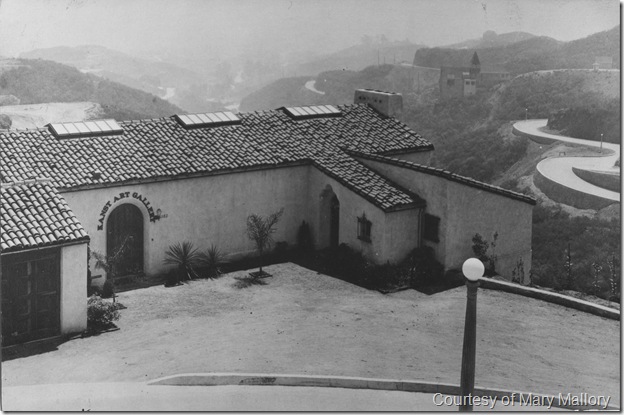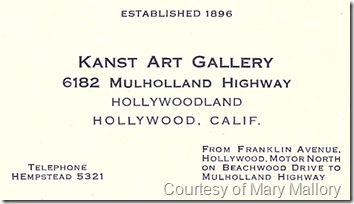
Note: This is an encore post from 2013.
The Hollywoodland housing development possessed many unique features when it opened in 1923. The neighborhood was the first themed housing development built on hillsides, the first to include a shopping center in its environs, and the first to house an art gallery. While the developers planned the first two elements on their own, the art gallery came into existence because of the dream of its builder, John F. Kanst. Kanst was Los Angeles’ veteran established art dealer when he bought land on Mulholland Highway to construct his dream home and art space.
Kanst arrived in Los Angeles in 1895 at the age of 32 intent on teaching the finer points of art to the public, training them to recognize and appreciate great works to buy for decoration of their homes. He arrived at a time when most people hung “chromos” or copies on their walls instead of original works. Kanst began buying paintings from Southern California artists and slowly began the process of educating the public about what art was and why it was important. As he would state, “An original painting of good quality is a living presence in the home.”
Hollywood at Play, by Donovan Brandt, Mary Mallory and Stephen X. Sylvester is now on sale.

To fund this ambition, Kanst joined a man named McClellan in 1896 to establish a proprietorship called the McClellan-Kanst Co. that offered framing, moldings, mirrors, and yes, pictures, to the public as a manufacturer and jobber. The company also sold little gifts and novelties at their store on 111-113-115 Winston St., opposite the Main Street post office.
In March 1907, Kanst bought out McClellan to establish his own company at 642 S. Spring St. called Kanst Art Co. He continued some of the same practices as he slowly began buying original watercolors and oil paintings and selling them. As he struggled through that first year, Kanst hustled for business by buying ads announcing he was cutting prices and even framing postal cards. In certain ways, Kanst was like Lamps Plus, always holding a sale. Kanst’s finances weren’t helped in 1909 when employee Allen J. Harvey was arrested and later sentenced to five years’ probation for taking paintings from the store.
Kanst sold off a large number of paintings in 1910 to travel to Europe for an art tour. When he returned, he began speaking to clubs and groups such as the California Art Club and Art Students League, as well as local women’s meetings. Kanst lectured on how dealers could educate and inform clients to improve their taste in art, as mentioned in an April 10, 1910, Los Angeles Times article. “In a land so new as our own, where deep culture is a rare quantity, the dealer has, in fact, to conduct a sort of ‘general store,’ where everyone may choose to suit his advancement; but where at the same time there will be some of the best for those who appreciate it.”
The gallery owner mentioned a buyer who began buying “commercial” pictures from a proprietor who sold copies. As the eye and taste of the collector grew, he moved from watercolors to oils and eventually to original works by local painters. Kanst also lectured on how architects needed to design more wall space in homes on which art could be hung.
 As Los Angeles Times columnist Arthur Miller wrote in Kanst’s 1933 obituary, “Kanst believed art expressed refined taste but also was one of the best investments a home owner could make.” It also helped create an atmosphere and impression of culture.
As Los Angeles Times columnist Arthur Miller wrote in Kanst’s 1933 obituary, “Kanst believed art expressed refined taste but also was one of the best investments a home owner could make.” It also helped create an atmosphere and impression of culture.
The Friday Morning Club arranged with Kanst to hold an exhibit of American painters in November 1910, starting his practice of regular openings, both here and at his new Pasadena location at Hotel Green in 1911. Another regular practice arose that year when he began hosting auctions of artwork, mostly for those who had to liquidate their holdings. By 1913, Kanst was listed in “Who’s Who on the Pacific Coast” and later the “San Francisco Blue Book.”
Kanst required a larger space for all his many activities, and in February 1915, moved to 826 S. Hill St. to a two-story brick office building constructed by Mrs. Susanna Van Nuys and designed by Morgan, Wells, & Morgan. One room at the new location functioned as gallery for serious art, another as store and gathering place, as Kanst held lectures and other social functions there. Kanst preached that Southern California would become the center of the art world in 20 years, though he was off by a few decades.
Kanst also provided artwork for a model bungalow in the Walnut Park development of Huntington Park in December 1917 as a way to sell his business. He needed it, because selling original art was a slow growing proposition. In 1917 and again in 1919, Kanst auctioned all of his paintings to pay his bills. This latter sale included Japanese chinoiserie and an Albert Bierstadt painting.
The cultural maven also provided a literary and cultural salon for Los Angeles’ residents, adding occasional meetings of the Drama League of America in 1921, and book talks and recitals in 1922. Unfortunately, money troubles caught up with him again in the fall 1923, and Kanst auctioned his works, moving his gallery to 2875 W. 7th St.
Kanst read many articles in 1923 about an exclusive housing development rising in the Beachwood Canyon area of the Hollywood Hills, with elegant homes possessing gorgeous views of Los Angeles and surrounding areas. He was hooked. In 1924, Kanst purchased property at 6182 Mulholland Highway to construct his long-held dream, a beautiful gallery located in an elegant home. Hollywoodland main architect John L. De Lario and Harbin F. Hunter designed a simple but lovely Spanish Revival home that accentuated its knockout views.
Arthur Miller noted in the Oct. 22, 1933, Los Angeles Times, “It was a favorite device of Mr. Kanst’s, after showing his guests the paintings, which, of course, they really came to see, to draw aside a curtain and astonish them with what he deemed his finest picture – the vast view below and beyond his house.” Kanst gladly provided a similar quote to Hollywoodland developers which they employed in their 1925 sales booklet.
Not only was this home the first one in Hollywoodland constructed on Mulholland Highway, but also the first residence in Los Angeles County built on the road.
In this gallery, Kanst exhibited the work of artist Charles M. Russell and many other recognized artists. Chicago illustrator and painter Joseph Birren arrived in May 1925 for a monthlong exhibit of his work. While in Hollywoodland, Birren painted three works documenting the area, “Lake Hollywood,” “Mulholland Dam,” and “Hollywoodland,” which were later exhibited there in 1926. I spoke with the Art Institute of Chicago in 2010 about them while researching “Hollywoodland,” and the museum could find no records that they have ever come up for auction. Only an illustration of “Hollywoodland” exists in the Nov. 14, 1926 edition of The Los Angeles Times.
Besides operating his gallery, Kanst continued educating the public through talks at clubs as well as loaning paintings for display in the Art Committee Room 351 in City Hall in April 1928.
Kanst’s Mulholland Highway home was a difficult place to reach unless one owned a sturdy car, so sometime in 1932 Kanst moved his gallery to 3349 Wilshire Blvd. He held an exhibit of masters like Reynolds, Corot, Inness, and Moran here late that year. Unfortunately health and financial issues forced him to sell all the paintings from the Wilshire gallery on Feb. 28, 1933.
Sadly, on Sept. 11, 1933, John F. Kanst passed away, and was laid to rest at Rosedale Cemetery. Miller’s Times Sept. 17 obituary noted that many of the best established artists gained their first exhibits with him, and that Kanst probably sold more paintings in Southern California than anyone. He acknowledged Kanst as one of Los Angeles’ best art educators as well. Kanst’s widow, Lura M. Kanst, vowed to carry on the gallery at her Mulholland Highway home, but no ads or stories ever appeared again about it.


Hollywoodland is immortalized as Santa Mira in the original ‘Invasion of the Body Snatchers’.
LikeLike